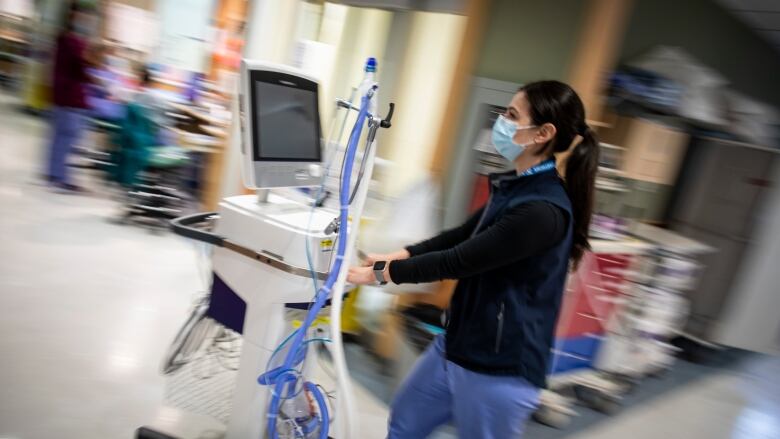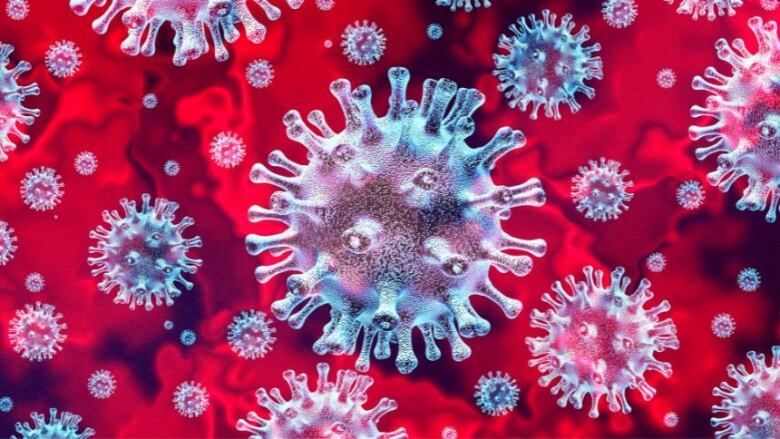COVID-19 kills 6 more in N.B., hospitalizations and ICU admissions rise, buck national trend
Decrease in case counts in line with national picture, weekly COVIDWatch report indicates

New Brunswick recorded six more deaths from COVID-19 in the past week andhospitalizations because of the virus have increased, along with the number of people who require intensive care, figures released by the province Tuesday show.
This bucks the national trend of a decrease in COVID deaths and hospitalizations, according to the COVIDWatch report.
The province's decline in COVIDcases,however, is in line with the national picture.
"At the national level, case counts continue to decline," the report says. "A decrease in outbreak incidence may indicate slowing transmission."
New Brunswickis facing a triple threat of respiratory viruses.In addition to COVID-19, the province has seenan 800 per cent increase in respiratory syncytial virus, or RSV, infections over the same time lastand increasing flu case counts, positivity rates and outbreaks,adding further strain on the health-care system.
Dr. Yves Lger, the acting chief medical officer of health, was unavailable again Tuesday for an interview, said Department of Health spokesperson Adam Bowie.
Deaths, hospitalizations
The latest deaths include one person in their 50s, two in their 80s and three 90 or older. The province's pandemic death toll now stands at609.
Twenty-four people were newly admitted to the hospital for COVID-19 between Nov. 13 and Nov. 19, up from 22.

The number of active hospitalizations also increased to 32,including six in intensive care, compared to 29 and zero respectively, the province's report says.
According to the regional health authorities, which reportpeople admitted to hospital because of COVID-19, as well as thoseinitially admitted for another reason who later test positive for the virus, there are 95 people hospitalized either for or with COVID. That's down from 131, butnine are in ICU, up from two.
The highest portion of hospitalizations for COVID-19 is among people aged 70 to 89, the COVIDWatch report says.
The latest admissions include a person in their 20s, one in their 40s, two in their 50s, five in their 60s, six in their 70s, six in their 80s, and three 90 or older.
2nd-highest case rate in Canada
A total of 739 new cases of COVID-19 were reported in the past week, down from 807.
That includes 436 cases confirmed through a PCR[polymerase chain reaction] lab test,down from518. The seven-day moving average of PCR-confirmed cases is now 62, compared to 74.
Another 303 people reported testing positive on a rapid test, up from 289.
There are 636 active cases of COVID across the province, based on PCRcases alone, down from 759.

New Brunswick has the second-highest rate of cases among the provinces, according to national data released Monday.
There were 64 cases per 100,000 population during the week ending Nov. 12, compared to the national average of 40, the figures show.
Only P.E.I. had a higher rate of cases at 105 per 100,000. Numbers for Saskatchewanare not included.
New Brunswick's rate of COVID-19 deaths for the same week was lower than the national average at 0.5 per 100,000, compared to0.7.
Only Alberta (0.4), Quebec (0.4) and Manitoba (0.3) ranked lower.Numbers for Saskatchewanare not included.
Nova Scotia had the highest rate among the provinces at 1.5 per 100,000, whileP.E.I. and Newfoundland and Labrador tied for second at 1.2.
Detailed breakdown of subvariantswithheld
Of New Brunswick's most recent random positive test result samples sent for genetic sequencing, 90 per cent were the highly transmissible Omicron subvariant BA.5, down from 94 per cent; eightper cent were the Omicron subvariant BA.4, up from five per cent; and two per cent were the Omicron subvariantBA.2, up from one per cent.
CBC requested a further breakdown of the subvariants, but the Department of Health refused to release the information.
Last week, CBC reported some offshoots of the COVID-19 Omicronsubvariant BA.5 sparking concern due to their growth advantage and signs of immune evasion are in New Brunswick and spreading.
A combined total of 338 cases of BQ.1, BQ.1.1 and BF.7have been detected in the province between August and October.
A case of BA.2.75.2, a sublineage of BA.2, which hasmutations that allow it tobetter evade immunity from vaccination and prior infection, was alsodetected inSeptember, the departmentpreviously confirmed.

The COVIDWatch report provides a breakdown of the five"majorbranches" of the Omicron variant BA.1, BA.2, BA.3, BA.4, and BA.5, which "are meant to inform the public about the most commonly spreading strains," the department spokesperson said.
"If the department determines there is a change of significance, or if there is value in sharing additional information about a certain variant, it may adjust the way it shares its data through its regular COVIDWatchreports," Bowie said in an emailed statement.
New Brunswick has had 82,223confirmed cases of COVID since the beginning of the pandemic. Of those, 80,978 are now considered resolved.
Second-booster rate rises
Another 4,646 doses of COVID-19 vaccines were administered in the past week, including 3,890 second booster shots, says the Department of Health.
That was enough to push the second-booster rate up to 26.3 per cent of eligible New Brunswickers, from 25.5 per cent.
Thefirst-booster rate(54.2 percent),two-dose rate (85.6 per cent), and one-dose rate (90.7 per cent) allremain unchanged.
Horizon andVitalit hospitalizations
Horizon has 72 active COVID-19 patients in hospital as of Saturday,down from 98,according to itsweekly COVID dashboard. Five of them require intensive care, up from one.
The majority, 30, are in the Saint John region, Zone 2, followed by 20 in the Fredericton region, Zone 3. The Moncton region, Zone 1, and the Miramichi region, Zone 7, each have 11 patients.
Several Horizon hospitals are near or overcapacity, as of Nov. 18, according to data provided by spokesperson Kris McDavid, but which ones have COVID patients or how manyis not indicated.
- Moncton Hospital, 93 per cent.
- Saint John Regional Hospital, 97 per cent.
- Dr. Everett Chalmers Regional Hospital,107 per cent.
- Upper River Valley Hospital, 110 per cent.
- Miramichi Regional Hospital,97 per cent.
Vitalit has 23COVID patients in hospital, downfrom33,its dashboard shows. Four of them require intensive care, up from one.
The Dr. Georges-L.-Dumont University Hospital Centre in Moncton has nine patients,including two in intensive care, and is listed at 112 per cent capacity;the Edmundston Regional Hospital has eight patients, including one in intensive care, and is listed at 93 per cent capacity;the Campbellton Regional Hospital has five patients, and is listed at 96 per cent capacity; and the Tracadie Hospital has one patient and is listed at 114 per cent capacity.
The bed occupancy rate at the other Vitalithospitals includes:
- Stella-Maris-de-Kent Hospital, 155 per cent.
- Grand Falls General Hospital, 85 per cent.
- Htel-Dieu Saint-Joseph de Saint-Quentin, 133 per cent.
- Chaleur Regional Hospital, 89 per cent.
- Enfant-Jsus RHSJHospital, 125 per cent.
- Lamque Hospital, 108 per cent.
Sick hospital employees, outbreaks
The number of Horizon health-care workers off the job because of COVIDhas jumped more than 41 per cent. Sixty-eight Horizon employees have tested positive for the virus, up from 48.
Vitalitstill has 31 sickemployees, unchanged from last week's report.
Horizon has COVID-19 outbreaks on 14 hospital units, down from 18 a week ago.These include four in the Moncton region, seven in the Saint John region, four in the Fredericton region and two in the Miramichi region. No other details are provided.
Vitalithas threeoutbreak units, including a new one at theEdmundston Regional Hospitalon theextended care unit and an ongoing one on the medicine unit, as well as the ongoing one on unit 300 atthe Veterans' Health Centre in the Moncton region, Zone 1.












_(720p).jpg)


 OFFICIAL HD MUSIC VIDEO.jpg)
.jpg)



























































































